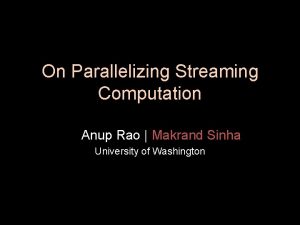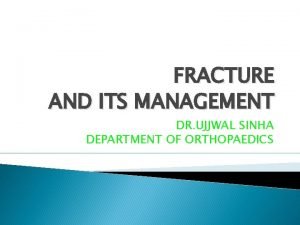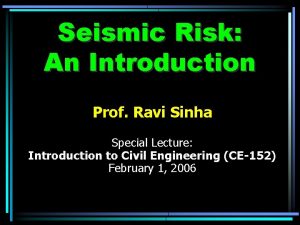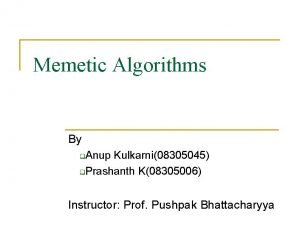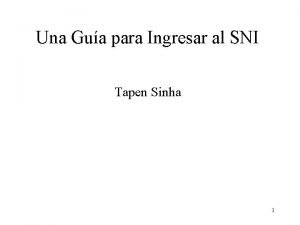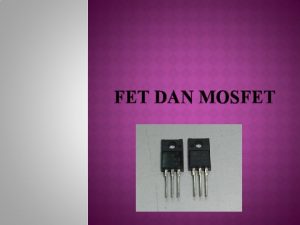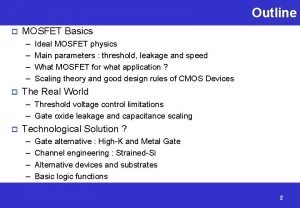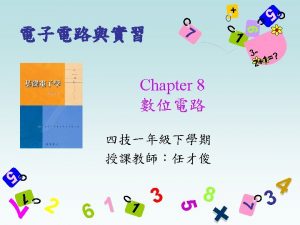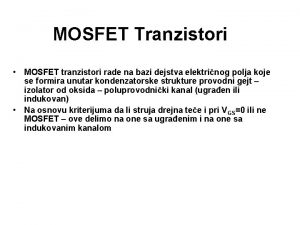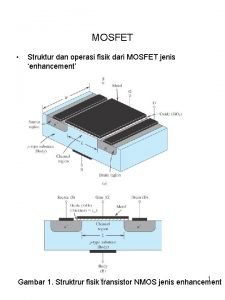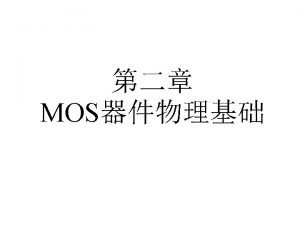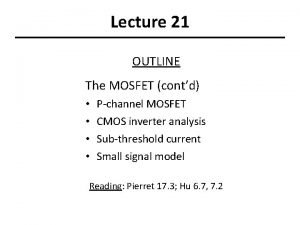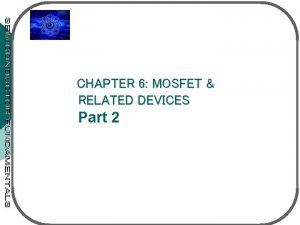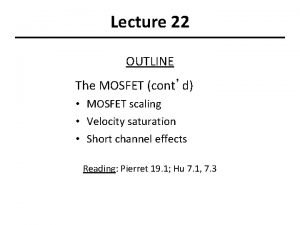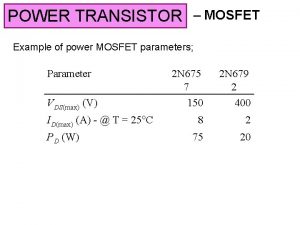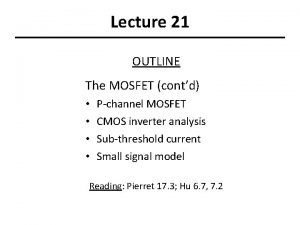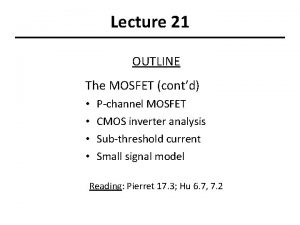MOSFET Sangeeta Sinha Physics Department A N College


















- Slides: 18

MOSFET ----Sangeeta Sinha Physics Department A N College

• • • Metal Oxide Field Effect Transistor -- MOSFET Insulated Gate Field Effect Transistor – IGFET Active Semiconductor Device • Two types – • • • 1. Enhancement MOSFET ( i) n- channel (ii) p-channel It has no channel between source and drain initially • • 2. Depletion MOSFET (i) n- channel (ii) p- channel • It has channel between source and drain from beginning •

Enhancement Type MOSFET Construction- n-channel Lightly doped p-type semiconductor bar – Substrate or Body


• • Two n-type well heavily doped- diffused into p-type semiconductor bar Two p-n junction – two depletion region of same width Source – one n-type well Drain - other n-type well Gate - A thin layer of Si. O 2 deposited between wells Metallic layer – over n-well , Si. O 2 layer and the bottom of bar Channel - no No current flow due to two p-n junction

Making a Channel • G and S connected to a battery

• The free electrons of p type accumulate near the Si. O 2 layer – behaves like di electric between plates of capacitor

Working When VGS = 0, it is normally off • When VGS – low , Electron accumulation less • VGS - increased , more electrons accumulation between n type wells • Hence, it behaves n type between wells inside the p type body – channel made

At certain voltage of VGS - channel is made – Threshold Voltage ( VT ) When VGS ≥ VT – Channel VGS < VT – no channel By increasing VGS , more electrons accumulation – more thick channel – behaves like n-type Inversion Process – p type material changed into n type material and vice-versa There is depletion layer around the channel Two p-n junction one between drain and body second between body and source

Now source and drain is connected by a battery(VDS) ID – current flows from drain to source •

• • ID increased with VDS Depletion layer thick at D side. Channel – narrow Channel becomes narrower with increased VDS ID not increased with VDS – saturated This value of ID – saturation Current Condition – Pinch off Value of VDS – saturation voltage – VDSat = VGS – VT

Drain Characteristic ( Output ) Graph between ID and VDS at different constant value of VGS

ID increases with VDS • At its certain value ID constant – independent of VDSat increasing with increased value of VGS Three region – 1. Active Region -The width of channel is changed with VGS at fixed value of VDS In This region MOSFET is operated as voltage controll resister 2. Cut- off Region – VGS < VT – MOSFET in off condition 3. Saturation Region. ID constant -- VDS ≥ VGS – VT

Transfer Characteristic ( Input ) • Graph between ID and VGS at constant VDS • For low value of VGS , no ID • Relation between ID and VGS expressed as • ID = K( VGS – VT )2 where K is device constant.

P - Channel MOSFET

SYMBOL

• Drain Characteristic • VGS negative • More negative VGS more ID

Transfer Characteristic • It is mirror image of n – channel curve
 Eacademics iitd
Eacademics iitd Odd man out stv xya kkt bde
Odd man out stv xya kkt bde Makrand sinha
Makrand sinha Klasifikasi negara menurut harold j. laski
Klasifikasi negara menurut harold j. laski Pradip sinha
Pradip sinha Durganand sinha ecological model of human development
Durganand sinha ecological model of human development Dr ankur sinha
Dr ankur sinha Dr ujjwal sinha
Dr ujjwal sinha Shan sinha
Shan sinha Ravi sinha iit bombay
Ravi sinha iit bombay Caroline poppenga
Caroline poppenga Dr abhinav sinha
Dr abhinav sinha Dr poonam sinha
Dr poonam sinha Manjira sinha
Manjira sinha Makrand sinha
Makrand sinha Chris sinha
Chris sinha Tapen sinha
Tapen sinha Sanjiv sinha
Sanjiv sinha Tapen sinha
Tapen sinha


